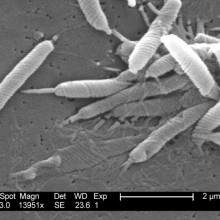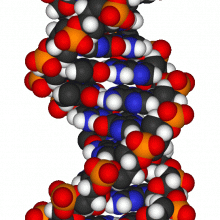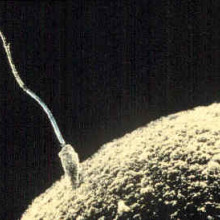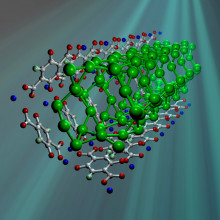This week, how gut bugs tell the story of our ancestors' migration into Australia and beyond, how RNA housekeeping allows humans to function with fewer genes than a banana, and how molecular metal cages safely store hydrogen, or sieve out carbon dioxide.
In this episode

Gut bugs and mother tongues shed light on pacific map
This week, two studies published in the journal Science found evidence from bugs that live inside our guts and the words that come out of our mouths, that both shed light on how ancient human ancestors migrated out of Asia and spread across the far reaches of the Pacific Ocean, a subject that has kept archaeologists scratching their heads for decades.
 Yoshan Moodley from the Max-Planck-Institut für Infektionsbiologie in Germany led a team of researchers who collected samples of gut bacteria called Helicobacter pylori from aboriginals living in Taiwan, Australia, Papua New Guinea, and New Caledonia.
Yoshan Moodley from the Max-Planck-Institut für Infektionsbiologie in Germany led a team of researchers who collected samples of gut bacteria called Helicobacter pylori from aboriginals living in Taiwan, Australia, Papua New Guinea, and New Caledonia.
These parasitic bacteria live inside the guts of around half the world's population who don't have access to modern medicines and can cause stomach ulcers. These bacteria are only found inside human beings, and so we think our ancestors carried them with them around the globe, the bacteria mutating and evolving into different strains along the way.
By sequencing the DNA of these gut bacteria, Moodley and his team discovered two new strains. The first one, called hp-sahul, they think split off from Asian ancestors around 30 thousand years ago probably when people migrated down through Indonesia, which back then when sea levels were lower and there was a land bridge to Australia and New Guinea, which together formed a single land mass known as Sahul.
A second strain of the bacteria, called hp-maori, was carried inside human hosts from Taiwan around 5 thousand years ago in a second wave of colonisation first to the Philippines then further south to Polynesia and New Zealand.
A Taiwanese origin of many Pacific tribes is also the conclusion reached by another group of researchers who studied languages. For a long time languages have been used to help unpick the past, because, rather like mutating bacteria, languages also change over time, and can be used to trace the relationships between groups of people in different parts of the world.
Russell Gray from the University of Auckland in New Zealand and his team analysed the relationships between 400 Austronesian languages spoken by tribes across the Pacific, focusing on patterns of similar words called cognates.
Cognates crop up in different languages where they sound similar and are thought to have a common origin. Take the word star in English, which is stella in Italian, sterna in German, ster in Dutch, estrella in Spanish, and so on suggesting a common link between these languages.
It took huge computing power to make thousands of comparisons between all the languages, and in doing so they found yet more evidence of a great southerly migration from Taiwan around 5 millennia ago that took place in fits and starts, probably as people developed better boats and colonised more and more distant clusters of islands.
It is amazing to think that there are messages from the past still hidden inside us - both in the words we speak and in the bugs that live in our stomachs.

Time to retrieve junk DNA from the trashcan
Scientists have discovered a role for the DNA that makes up the majority of the genome but which had previously been written off as rubbish.
 Writing in the journal Molecular Cell, Edinburgh University researcher David Tollervey and his colleagues explain how these non-coding segments of DNA, which lie between the known genes, actually give rise to a large number of chemical messengers that regulate the control of other genes. Working with yeast cells, which are very similar albeit slightly simpler than human cells, the researchers found that the non-coding DNA produces sequences of its chemical relative RNA.
Writing in the journal Molecular Cell, Edinburgh University researcher David Tollervey and his colleagues explain how these non-coding segments of DNA, which lie between the known genes, actually give rise to a large number of chemical messengers that regulate the control of other genes. Working with yeast cells, which are very similar albeit slightly simpler than human cells, the researchers found that the non-coding DNA produces sequences of its chemical relative RNA.
Normally, RNA molecules are used to translate the genetic recipes written into the genome into proteins that carry out important functions in a cell. But these so-called non-coding RNAs that the Edinburgh team have been studying are different.
Instead they are used to control the addition or removal of chemical tags (methyl or acetyl groups) from the DNA and this process, known as histone modification, can powerfully affect the activity of the tagged gene.
"Cells contain about 2 metres of DNA, which needs to be tightly packaged within the nucleus," explains Tollervey. "This is achieved by winding the DNA into a tight configuration called chromatin. But by modifying the DNA through the addition of these chemicals cells are able to ensure that certain genes remain accessible and active."
This is the chemical-equivalent of moving the things you use most often to the front of your cupboards so that they are easier to reach.
"We think that this process allows the yeast to control its gene activity more tightly to take advantage of different environmental conditions or food sources," says Tollervey. But in humans it also answers another important question - why we can get away with having fewer genes than a banana!

The need for speedy sperm
When it comes to being a male fish, life can be tough when the lady in your life gets around a bit and mates with lots of other males. It means that to make sure you produce lots of offspring you must compete with all the other guys on the scene, and more specifically your sperm has to be up to the job.
 Now a team researchers led by John Fitzpatrick from the University of Western Australia have shown for the first time in the journal PNAS that when male fish have to compete with each other on a daily basis for the chance to mate, their sperm evolves to be bigger and faster.
Now a team researchers led by John Fitzpatrick from the University of Western Australia have shown for the first time in the journal PNAS that when male fish have to compete with each other on a daily basis for the chance to mate, their sperm evolves to be bigger and faster.
When polygynous fish mate, a female lay eggs and males then rush in to add their sperm, hoping they will be the first in there.
For a long time now, biologists have suspected that polygynous males must evolve tactical sperm that are faster and therefore more likely to reach the eggs first, but up until now, no solid proof of that idea has been found.
Fitzpatrick and his team looked at species of cichlid fish living in Lake Tanganyika in Africa. Cichlids are famous for having evolved extremely rapidly into lots of different species. Some cichlids are monogamous, and others that are highly promiscuous, sharing many different partners throughout their life.
By zeroing in on these cichlids with all different types of mating behaviour, it allowed researchers to unpick this issue of the evolution of sperm.
The researchers went scuba diving in the lake and caught male fish from 29 different species and dissected them to study their sperm. They measured sperm length under a microscope and used digital video cameras to measure how fast the sperm were swimming. They found out that the polygynous species with lots of mates did indeed have larger, faster sperm than the monogamous species.
This was also the first time that good evidence has been gathered to prove that when sperm are bigger they do indeed swim faster, because their tails or flagella are longer, and can generate more propulsion.
And from earlier studies that have drawn up the family tree of all these cichlid fish, Fitzpatrick and his team were able to work out that the ancient cichlids that first colonised the lake had small, slow moving sperm, and as promiscuity increased over time among certain lineages, so sperm began to evolve to be bigger and faster.
Cichlid fish are the first group of species that have demonstrated the evolution of speedy sperm in polygynous species, but it is likely that similar things are going on in many other species where males have to do whatever they can to make sure they pass on their genes to the next generation.

10:46 - MOF's and Molecular Sieves
MOF's and Molecular Sieves
Professor Joe Hupp, Northwestern University
Chris - We now have Joe Hupp from Northwestern University. Hello Joe. What are these moths and what's their structure if you could zoom in with a very powerful microscope and see them, what would they look like?
Joe - Metal atoms or ions on the corners and then rigid pillars that are made or organic molecules. Each collection of these defines a cage but the cages go on forever and an important property of these is that they're not just isolated cages, they're crystalline materials. If you did zoom in and look at one of these cages you would see a tunnel going on forever with exactly the same size cage all the way through.
 Chris - So it's almost like children's building blocks but with a hole in the middle that you can connect together to make enormously voluminous containers but at a molecular level.
Chris - So it's almost like children's building blocks but with a hole in the middle that you can connect together to make enormously voluminous containers but at a molecular level.
Joe - That's right. The materials have surface areas that are gigantic. The largest are more than 6000 square metres per gram. They have the lowest densities of many known crystalline materials. They have gigantic interior volumes. Some of them are more than 80% empty so these tiny walls define lots of miniscule spaces. The important thing is the space is on the size of a molecule. That's what enables them to store molecules like hydrogen or methane for fuel or to, as you mentioned pull some molecules off the mixture.
Chris - Just to add some perspective, 6000m squared is as big as a football pitch so per gram that's incredible. When you say that you actually make these things with metal atoms on the corner - if we imagine a cube - which is the simplest structural and functional unit you've got a metal atom on the corner of the cube and they're connected by these organic linkers. How do you actually make these things?
Joe - Well they turn out to be pretty easy to make. It's just hard to make them well. You simply cook them, the pieces that are sticky for the metal ions, in a mixture for four or five days. If everything goes right you get crystals. What we typically do it try three or four hundred sets of conditions and a few of them work. It's really a very empirical science at the moment.
Chris - how much of these things can you make? Are we talking per gram quantities or are you making a reasonable amount that could hold reasonable amounts of molecules?
Joe - In the laboratory we are designing these and scouting these for very specific purposes so we only need tens or hundreds of milligrams. BASF which is the world's largest chemical company has demonstrated that it's easy with the right materials to make kilogram quantities of these. In fact they've driven a demonstration vehicle across Europe where the fuel tanks are filled with methane. What stores the methane are these tiny cavities?
Chris - Could you just explain to us how these tiny cavities are useful for storing methane? Why is it better to use a complex crystal like this than to just put a large cylinder of gas in the back of the car?
Joe - Well, first of all I don't think you or I would want to drive a car that had a stainless steel cylinder in the back in case of a collision. The methane is much more safely stored if it's in a container that's not much bigger than the methane itself. It turns out that in order to stick to the material it has to be very close to it. In a stainless steel tank most of the molecules never touch the wall. It's better to have tiny channels and have the molecules adhere to them.
Chris - can you tell us, because one of the things I mentioned, that you could scrub out gases from flues and exhaust pipes, for example. Could you make a molecule that has a cavity that's chemically-active enough to grab one species of chemical or waste gas you don't want going into the atmosphere and let less harmful things go past. A kind of molecule sieve, if you like.
Joe - There's lots of interesting work on, for example, pulling carbon dioxide out of methane. One of the companies in the United States, Innovene Chemicals, spends a half billion dollars a year doing this with freezers. They condense carbon dioxide to a liquid to get it out of natural gas and the reason they spend half a billion dollars a year on this is because they can mark up the price of the gas by more than a half billion dollars a year. It's very energy intensive and they would much prefer to have a material that just grabbed all the carbon dioxide and left the natural gas, the methane behind.
Related Content
- Previous Counting Without Counting
- Next Material, Heal Thyself










Comments
Add a comment